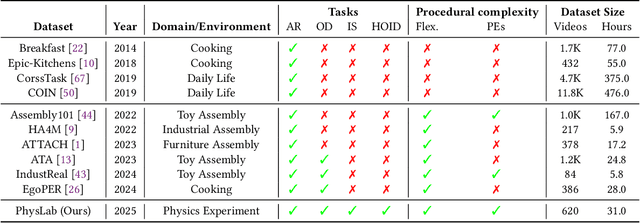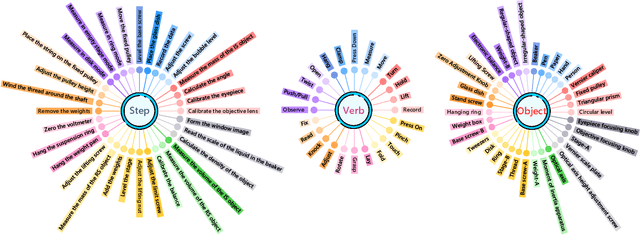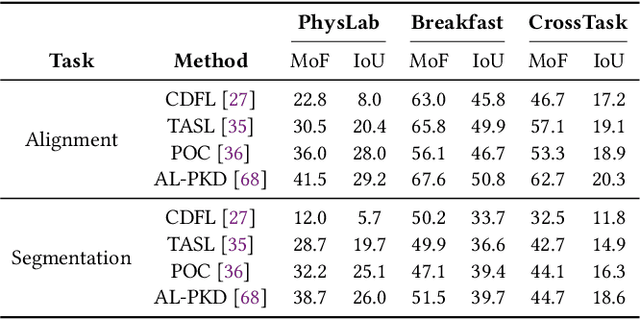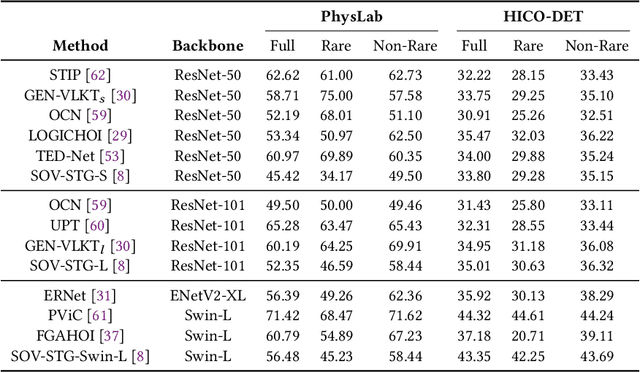Zilong Wang
A Tale of LLMs and Induced Small Proxies: Scalable Agents for Knowledge Mining
Oct 01, 2025Abstract:At the core of Deep Research is knowledge mining, the task of extracting structured information from massive unstructured text in response to user instructions. Large language models (LLMs) excel at interpreting such instructions but are prohibitively expensive to deploy at scale, while traditional pipelines of classifiers and extractors remain efficient yet brittle and unable to generalize to new tasks. We introduce Falconer, a collaborative framework that combines the agentic reasoning of LLMs with lightweight proxy models for scalable knowledge mining. In Falconer, LLMs act as planners, decomposing user instructions into executable pipelines, and as annotators, generating supervision to train small proxies. The framework unifies classification and extraction into two atomic operations, get label and get span, enabling a single instruction-following model to replace multiple task-specific components. To evaluate the consistency between proxy models incubated by Falconer and annotations provided by humans and large models, we construct new benchmarks covering both planning and end-to-end execution. Experiments show that Falconer closely matches state-of-the-art LLMs in instruction-following accuracy while reducing inference cost by up to 90% and accelerating large-scale knowledge mining by more than 20x, offering an efficient and scalable foundation for Deep Research.
GenBreak: Red Teaming Text-to-Image Generators Using Large Language Models
Jun 11, 2025Abstract:Text-to-image (T2I) models such as Stable Diffusion have advanced rapidly and are now widely used in content creation. However, these models can be misused to generate harmful content, including nudity or violence, posing significant safety risks. While most platforms employ content moderation systems, underlying vulnerabilities can still be exploited by determined adversaries. Recent research on red-teaming and adversarial attacks against T2I models has notable limitations: some studies successfully generate highly toxic images but use adversarial prompts that are easily detected and blocked by safety filters, while others focus on bypassing safety mechanisms but fail to produce genuinely harmful outputs, neglecting the discovery of truly high-risk prompts. Consequently, there remains a lack of reliable tools for evaluating the safety of defended T2I models. To address this gap, we propose GenBreak, a framework that fine-tunes a red-team large language model (LLM) to systematically explore underlying vulnerabilities in T2I generators. Our approach combines supervised fine-tuning on curated datasets with reinforcement learning via interaction with a surrogate T2I model. By integrating multiple reward signals, we guide the LLM to craft adversarial prompts that enhance both evasion capability and image toxicity, while maintaining semantic coherence and diversity. These prompts demonstrate strong effectiveness in black-box attacks against commercial T2I generators, revealing practical and concerning safety weaknesses.
PhysLab: A Benchmark Dataset for Multi-Granularity Visual Parsing of Physics Experiments
Jun 07, 2025



Abstract:Visual parsing of images and videos is critical for a wide range of real-world applications. However, progress in this field is constrained by limitations of existing datasets: (1) insufficient annotation granularity, which impedes fine-grained scene understanding and high-level reasoning; (2) limited coverage of domains, particularly a lack of datasets tailored for educational scenarios; and (3) lack of explicit procedural guidance, with minimal logical rules and insufficient representation of structured task process. To address these gaps, we introduce PhysLab, the first video dataset that captures students conducting complex physics experiments. The dataset includes four representative experiments that feature diverse scientific instruments and rich human-object interaction (HOI) patterns. PhysLab comprises 620 long-form videos and provides multilevel annotations that support a variety of vision tasks, including action recognition, object detection, HOI analysis, etc. We establish strong baselines and perform extensive evaluations to highlight key challenges in the parsing of procedural educational videos. We expect PhysLab to serve as a valuable resource for advancing fine-grained visual parsing, facilitating intelligent classroom systems, and fostering closer integration between computer vision and educational technologies. The dataset and the evaluation toolkit are publicly available at https://github.com/ZMH-SDUST/PhysLab.
Training Language Models to Generate Quality Code with Program Analysis Feedback
May 28, 2025Abstract:Code generation with large language models (LLMs), often termed vibe coding, is increasingly adopted in production but fails to ensure code quality, particularly in security (e.g., SQL injection vulnerabilities) and maintainability (e.g., missing type annotations). Existing methods, such as supervised fine-tuning and rule-based post-processing, rely on labor-intensive annotations or brittle heuristics, limiting their scalability and effectiveness. We propose REAL, a reinforcement learning framework that incentivizes LLMs to generate production-quality code using program analysis-guided feedback. Specifically, REAL integrates two automated signals: (1) program analysis detecting security or maintainability defects and (2) unit tests ensuring functional correctness. Unlike prior work, our framework is prompt-agnostic and reference-free, enabling scalable supervision without manual intervention. Experiments across multiple datasets and model scales demonstrate that REAL outperforms state-of-the-art methods in simultaneous assessments of functionality and code quality. Our work bridges the gap between rapid prototyping and production-ready code, enabling LLMs to deliver both speed and quality.
RRO: LLM Agent Optimization Through Rising Reward Trajectories
May 27, 2025Abstract:Large language models (LLMs) have exhibited extraordinary performance in a variety of tasks while it remains challenging for them to solve complex multi-step tasks as agents. In practice, agents sensitive to the outcome of certain key steps which makes them likely to fail the task because of a subtle mistake in the planning trajectory. Recent approaches resort to calibrating the reasoning process through reinforcement learning. They reward or penalize every reasoning step with process supervision, as known as Process Reward Models (PRMs). However, PRMs are difficult and costly to scale up with a large number of next action candidates since they require extensive computations to acquire the training data through the per-step trajectory exploration. To mitigate this issue, we focus on the relative reward trend across successive reasoning steps and propose maintaining an increasing reward in the collected trajectories for process supervision, which we term Reward Rising Optimization (RRO). Specifically, we incrementally augment the process supervision until identifying a step exhibiting positive reward differentials, i.e. rising rewards, relative to its preceding iteration. This method dynamically expands the search space for the next action candidates, efficiently capturing high-quality data. We provide mathematical groundings and empirical results on the WebShop and InterCode-SQL benchmarks, showing that our proposed RRO achieves superior performance while requiring much less exploration cost.
The Price of Format: Diversity Collapse in LLMs
May 25, 2025Abstract:Instruction-tuned large language models (LLMs) employ structured templates, such as role markers and special tokens, to enforce format consistency during inference. However, we identify a critical limitation of such formatting: it induces a phenomenon we term diversity collapse, where the model generates semantically similar outputs for open-ended inputs, undermining creativity and variability. We systematically evaluate this effect across tasks like story completion and free-form generation, finding that (1) diversity collapse persists even under high-temperature sampling, and (2) structural tokens in templates significantly constrain the model's output space. To contextualize these findings, we fine-tune the same model using a range of structured prompts and then evaluate them across three axes: downstream task performance, alignment behavior, and output diversity. Our analysis shows that format consistency between fine-tuning and inference is crucial for structure-sensitive tasks (e.g., GSM8K, IFEval), but has marginal influence on knowledge-heavy tasks (e.g., MMLU, WebQuestions). In contrast, output diversity is primarily governed by the presence or absence of structural tokens, with minimal formatting yielding the most diverse outputs. These findings reveal that current prompting conventions, while beneficial for alignment, may inadvertently suppress output diversity, underscoring the need for diversity-aware prompt design and instruction tuning.
Do Not Let Low-Probability Tokens Over-Dominate in RL for LLMs
May 19, 2025Abstract:Reinforcement learning (RL) has become a cornerstone for enhancing the reasoning capabilities of large language models (LLMs), with recent innovations such as Group Relative Policy Optimization (GRPO) demonstrating exceptional effectiveness. In this study, we identify a critical yet underexplored issue in RL training: low-probability tokens disproportionately influence model updates due to their large gradient magnitudes. This dominance hinders the effective learning of high-probability tokens, whose gradients are essential for LLMs' performance but are substantially suppressed. To mitigate this interference, we propose two novel methods: Advantage Reweighting and Low-Probability Token Isolation (Lopti), both of which effectively attenuate gradients from low-probability tokens while emphasizing parameter updates driven by high-probability tokens. Our approaches promote balanced updates across tokens with varying probabilities, thereby enhancing the efficiency of RL training. Experimental results demonstrate that they substantially improve the performance of GRPO-trained LLMs, achieving up to a 46.2% improvement in K&K Logic Puzzle reasoning tasks. Our implementation is available at https://github.com/zhyang2226/AR-Lopti.
Neural-Inspired Advances in Integral Cryptanalysis
May 16, 2025Abstract:The study by Gohr et.al at CRYPTO 2019 and sunsequent related works have shown that neural networks can uncover previously unused features, offering novel insights into cryptanalysis. Motivated by these findings, we employ neural networks to learn features specifically related to integral properties and integrate the corresponding insights into optimized search frameworks. These findings validate the framework of using neural networks for feature exploration, providing researchers with novel insights that advance established cryptanalysis methods. Neural networks have inspired the development of more precise integral search models. By comparing the integral distinguishers obtained via neural networks with those identified by classical methods, we observe that existing automated search models often fail to find optimal distinguishers. To address this issue, we develop a meet in the middle search framework that balances model accuracy and computational efficiency. As a result, we reduce the number of active plaintext bits required for an 11 rounds integral distinguisher on SKINNY64/64, and further identify a 12 rounds key dependent integral distinguisher achieving one additional round over the previous best-known result. The integral distinguishers discovered by neural networks enable key recovery attacks on more rounds. We identify a 7 rounds key independent integral distinguisher from neural networks with even only one active plaintext cell, which is based on linear combinations of bits. This distinguisher enables a 15 rounds key recovery attack on SKINNYn/n, improving upon the previous record by one round. Additionally, we discover an 8 rounds key dependent integral distinguisher using neural network that further reduces the time complexity of key recovery attacks against SKINNY.
Exploring Interpretability for Visual Prompt Tuning with Hierarchical Concepts
Mar 08, 2025Abstract:Visual prompt tuning offers significant advantages for adapting pre-trained visual foundation models to specific tasks. However, current research provides limited insight into the interpretability of this approach, which is essential for enhancing AI reliability and enabling AI-driven knowledge discovery. In this paper, rather than learning abstract prompt embeddings, we propose the first framework, named Interpretable Visual Prompt Tuning (IVPT), to explore interpretability for visual prompts, by introducing hierarchical concept prototypes. Specifically, visual prompts are linked to human-understandable semantic concepts, represented as a set of category-agnostic prototypes, each corresponding to a specific region of the image. Then, IVPT aggregates features from these regions to generate interpretable prompts, which are structured hierarchically to explain visual prompts at different granularities. Comprehensive qualitative and quantitative evaluations on fine-grained classification benchmarks show its superior interpretability and performance over conventional visual prompt tuning methods and existing interpretable methods.
Memorize or Generalize? Evaluating LLM Code Generation with Evolved Questions
Mar 04, 2025Abstract:Large Language Models (LLMs) are known to exhibit a memorization phenomenon in code generation: instead of truly understanding the underlying principles of a programming problem, they tend to memorize the original prompt and its solution together in the training. Consequently, when facing variants of the original problem, their answers very likely resemble the memorized solutions and fail to generalize. In this paper, we investigate this phenomenon by designing three evolution strategies to create variants: mutation, paraphrasing, and code-rewriting. By comparing the performance and AST similarity of the LLM-generated codes before and after these three evolutions, we develop a memorization score that positively correlates with the level of memorization. As expected, as supervised fine-tuning goes on, the memorization score rises before overfitting, suggesting more severe memorization. We demonstrate that common mitigation approaches, such as prompt translation and using evolved variants as data augmentation in supervised learning and reinforcement learning, either compromise the performance or fail to alleviate the memorization issue. Therefore, memorization remains a significant challenge in LLM code generation, highlighting the need for a more effective solution.
 Add to Chrome
Add to Chrome Add to Firefox
Add to Firefox Add to Edge
Add to Edge